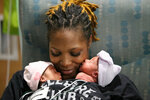According to professionals at USA Health, a warm hug between a parent and child can mend more than meets the eye, with science backing up the benefits of this simple yet powerful act.
To …
This item is available in full to subscribers.
Please log in to continue |


According to professionals at USA Health, a warm hug between a parent and child can mend more than meets the eye, with science backing up the benefits of this simple yet powerful act.
To recognize the importance of the parental bonding technique known as skin-to-skin contact, 36 families with infants in the neonatal intensive care unit (NICU) at USA Health Children's & Women's Hospital spent time snuggling with their babies during Kangaroo Care Awareness Day on May 15.
The practice, named for the way a kangaroo cradles its young in a pouch after birth, offers numerous benefits for human infants. Research shows that kangaroo care helps stabilize heart rates, improve oxygen saturation and respiratory rates and increase milk production for mothers. It also reduces stress for the tiniest patients in the NICU, who are often separated from their parents and caregivers for extended periods.
At the region's only level III NICU, physicians and nurses dressed in kangaroo suits posed for photos with many of the families as part of the day's festivities. Parents also participated in a class where they decorated frames to mark the occasion. These frames, along with other treats, were donated by the Skylar Project, a local nonprofit supporting NICU parents.
"A great thing about this technique is that moms and dads can both participate," said Courtney Thomson, RNC-NIC, BSN, a parent educator in the NICU. "Having a child in an intensive care unit can often be a challenging experience. That's one reason we create opportunities, such as Kangaroo Care Awareness Day, for parents and newborns to share positive experiences that enhance bonding."
Here's how the skin-to-skin technique works: